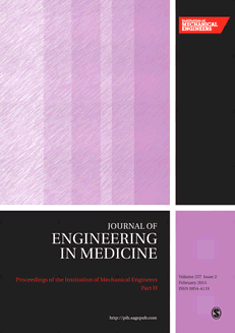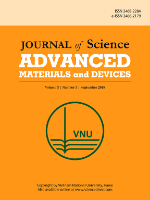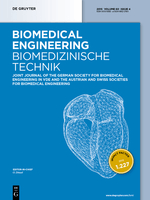
Journal of Biomimetics Biomaterials and Biomedical Engineering
Scope & Guideline
Harnessing Nature's Genius for Cutting-Edge Health Solutions
Introduction
Aims and Scopes
- Biomimetic Materials Development:
Research in this area emphasizes the creation of materials that mimic biological structures and functions, enhancing properties like biocompatibility and mechanical strength for applications in medical implants and devices. - Biomedical Engineering Innovations:
The journal covers cutting-edge engineering solutions applied to healthcare challenges, including the development of diagnostic tools, rehabilitation devices, and advanced prosthetics. - Nanotechnology in Medicine:
A significant focus on the use of nanomaterials for drug delivery, antimicrobial applications, and tissue engineering, highlighting the innovative synthesis and characterization methods. - Computational and Experimental Biomechanics:
Studies involving numerical simulations and experimental analyses to understand biomechanical behaviors, particularly in the context of implants and prosthetic devices. - Interdisciplinary Approaches to Health Solutions:
Research that integrates multiple disciplines such as biology, engineering, and material science to address complex health problems and improve medical technologies.
Trending and Emerging
- Smart and Responsive Biomaterials:
There is a growing trend towards developing materials that respond to environmental stimuli (e.g., temperature, pH), which can significantly enhance their utility in biomedical applications such as drug delivery and tissue engineering. - Sustainable and Green Synthesis Techniques:
Research on environmentally friendly methods for synthesizing nanomaterials and biomaterials is on the rise, emphasizing the importance of sustainability in biomedical engineering. - Advanced Imaging and Diagnostic Technologies:
Emerging studies in the application of imaging technologies and machine learning for diagnostics, particularly in the context of cancer detection and monitoring, are gaining traction. - Wearable and Implantable Health Monitoring Devices:
An increase in research focused on the development of smart wearables and implantable devices for real-time health monitoring reflects the growing intersection of technology and personal health management. - Regenerative Medicine and Tissue Engineering Innovations:
Research in regenerative medicine, particularly focused on stem cell applications and scaffold development for tissue engineering, is experiencing a notable increase, highlighting the need for advanced solutions in healthcare.
Declining or Waning
- Traditional Biomaterials without Novel Enhancements:
The focus on conventional biomaterials without significant innovation or modification has waned, as the field increasingly seeks advanced materials that offer superior performance and functionalities. - Basic Studies on Biocompatibility:
Research solely centered on biocompatibility testing without the integration of innovative applications or advanced methodologies has become less prevalent, reflecting a shift towards more applied research. - Generalized Review Articles:
The volume of broad, non-specific review articles has decreased, as the journal now favors more targeted and novel research findings that contribute directly to ongoing scientific discourse. - Conventional Drug Delivery Systems:
Research on traditional drug delivery systems has declined as new, more efficient methods and materials (e.g., nanocarriers) have captured the interest of researchers, reflecting a trend towards innovation.
Similar Journals

BIOMEDICAL ENGINEERING-APPLICATIONS BASIS COMMUNICATIONS
Fostering collaboration in the realm of biomedical engineering.BIOMEDICAL ENGINEERING-APPLICATIONS BASIS COMMUNICATIONS is a prominent journal dedicated to the dynamic field of biomedical engineering, published by WORLD SCIENTIFIC PUBL CO PTE LTD. Since its inception in 1992, the journal has provided a platform for the dissemination of high-quality research and innovative applications within the biomedical engineering domain. Despite its current Q4 ranking in multiple categories such as Bioengineering and Biomedical Engineering, the journal serves as an essential resource for researchers and professionals seeking to explore the latest developments and practical applications in this interdisciplinary field. The journal is based in Singapore, reflecting the region's growing influence in scientific research and technology. Although it does not offer open access, it continues to attract submissions that enrich the scientific dialogue within its community. With a commitment to fostering knowledge and research collaboration, this journal remains a vital contributor to the ongoing advancements in biomedical technology and engineering.

PROCEEDINGS OF THE INSTITUTION OF MECHANICAL ENGINEERS PART H-JOURNAL OF ENGINEERING IN MEDICINE
Empowering Healthcare: The Intersection of Engineering and MedicineProceedings of the Institution of Mechanical Engineers Part H - Journal of Engineering in Medicine is a pivotal publication in the interdisciplinary realm of mechanical engineering and medical technology. Published by SAGE Publications Ltd, this esteemed journal delivers cutting-edge research and innovative solutions that bridge the gap between engineering principles and medical applications. With an impressive reputation, the journal is ranked in the Q2 category for Mechanical Engineering and Q3 for miscellaneous Medicine in 2023, reflecting its significant contribution to the field. Boasting an impact factor that positions it favorably in both mechanical engineering and medical research, it serves as a critical platform for researchers, professionals, and students eager to advance their knowledge and influence the future of engineering in healthcare. This journal encompasses diverse topics, driving forward the synergy between engineering and medicine while promoting discussions and discoveries that shape industry practices globally.

JOURNAL OF BIOMEDICAL MATERIALS RESEARCH PART B-APPLIED BIOMATERIALS
Exploring New Horizons in Applied BiomaterialsJOURNAL OF BIOMEDICAL MATERIALS RESEARCH PART B-APPLIED BIOMATERIALS, published by Wiley, is a leading journal in the field of biomaterials and biomedical engineering, with an impact factor reflected in its relevant Scopus rankings—including a Q2 position in Biomedical Engineering and Q3 in Biomaterials for 2023. This journal, with ISSN 1552-4973 and E-ISSN 1552-4981, serves as a vital platform for disseminating pioneering research and innovative applications of biomaterials. Positioned in the United States, it aims to bridge the gap between material science and biological applications, fostering collaboration among researchers, professionals, and students dedicated to advancing technology in healthcare. With a convergence of studies from 2003 to 2024 and a growing focus on open access, the journal ensures greater visibility and accessibility for groundbreaking research. Join us in exploring the dynamic field of biomaterials, as we push the boundaries of science and engineering for improved patient outcomes.

Biomedical Materials
Transforming Science into Life-Saving Solutions.Biomedical Materials, published by IOP Publishing Ltd, is a premier journal dedicated to the rapidly evolving field of biomedical engineering and materials science. With a robust impact factor showcasing its influence, this journal serves as a vital platform for disseminating pioneering research from 2006 to 2024. Covering an array of interdisciplinary topics—ranging from biomaterials to bioengineering and applied chemistry—the journal consistently ranks in the second quartile across multiple categories including Bioengineering (Q2), Biomaterials (Q2), and Biomedical Engineering (Q2) as of 2023. Researchers, professionals, and students alike benefit from its contributions, exploring innovative solutions at the intersection of biology and material science. Although not an Open Access journal, Biomedical Materials remains essential in advancing our understanding and facilitating discussions surrounding state-of-the-art materials that revolutionize medical applications and enhance patient care.

BIO-MEDICAL MATERIALS AND ENGINEERING
Transforming healthcare through cutting-edge research.BIO-MEDICAL MATERIALS AND ENGINEERING, published by IOS PRESS, serves as a vital platform for advancing the fields of biomaterials and biomedical engineering. With its ISSN 0959-2989 and E-ISSN 1878-3619, the journal has been consistently disseminating high-quality research since its inception in 1991, covering a diverse range of studies on the development and application of biomedical materials. Although currently classified in the Q4 quartile in several categories including biomaterials and biomedical engineering, the journal aims to appeal to a broad audience of researchers and professionals, fostering collaboration and innovation in translating new materials into clinical practice. Located in the Netherlands, it emphasizes the importance of interdisciplinary approaches and provides a forum for new ideas and findings that could significantly impact healthcare solutions. While not an open-access journal, it provides various access options to maximize the reach and engagement of its research. Researchers, practitioners, and students alike will find valuable insights and comprehensive studies within its pages, contributing to the continued evolution of biomedical sciences.

Advanced Biomedical Engineering
Connecting scholars to shape the landscape of biomedical engineering.Advanced Biomedical Engineering is a peer-reviewed open access journal published by the Japanese Society for Medical & Biological Engineering, dedicated to disseminating high-quality research in the multidisciplinary fields of biomedical engineering. Boasting an ISSN of 2187-5219, this journal has been pivotal since its inception in 2018, especially as it embraces the open access model to foster knowledge sharing and wide accessibility. Centered in Tokyo, Japan, it serves as a vital platform for scholars and practitioners across various domains, such as biomaterials, biomedical engineering, and biotechnology. Despite currently residing in the Q4 quartile across several categories, including those in biotechnology and computer science applications, the journal is committed to elevating its academic impact and reputation, aiming for improved rankings in Scopus and other databases. Researchers and professionals are encouraged to contribute their innovative findings, discussions, and case studies, facilitating the advancement of this dynamic field.

Biosurface and Biotribology
Driving Innovation in Tribological Behavior and Material ScienceBiosurface and Biotribology, published by WILEY, is an innovative Open Access journal that has been dedicated to advancing the fields of biomaterials, biomedical engineering, and tribology since its inception. With a focus on the surface interactions and tribological behaviors of materials, this journal serves as an essential platform for researchers and professionals eager to explore the intersections of engineering, materials science, and biophysics. While it holds a current categorization in the Q4 quartile for biomaterials and biomedical engineering and a Q3 ranking in mechanical engineering, the journal's commitment to disseminating high-quality, peer-reviewed research contributes to its growing visibility and relevance in the academic landscape. With open access since 2018, it ensures that the latest research is freely available to all, fostering collaboration and innovation. Whether you are a graduate student, a seasoned researcher, or a professional in the field, Biosurface and Biotribology is your gateway to cutting-edge insights and developments that are shaping the future of biomaterials and surface engineering.

JOURNAL OF BIOMATERIALS SCIENCE-POLYMER EDITION
Shaping the future of bioengineering with polymer innovations.JOURNAL OF BIOMATERIALS SCIENCE-POLYMER EDITION, published by Taylor & Francis Ltd, is a distinguished scholarly journal dedicated to the exploration of biomaterials and their applications in various fields such as bioengineering, biomedical engineering, and biophysics. With an ISSN of 0920-5063 and an E-ISSN of 1568-5624, this journal offers a platform for researchers and professionals to share innovative findings and methodologies that advance the science of polymer-based biomaterials. The journal's impact within the academic community is underscored by its notable Scopus rankings, including a Q2 status in both Biomedical Engineering and Biophysics as of 2023, reflecting its significant contribution to advancing knowledge and practice in these fields. The scope of the journal spans from fundamental research to applications in medical devices and regenerative medicine, ensuring comprehensive coverage of the latest trends and breakthroughs. Although it does not currently offer open access options, the journal remains a pivotal resource for students, researchers, and professionals committed to the development and application of biomaterials in healthcare. For further details, the journal is based in Abingdon, United Kingdom, at 2-4 Park Square, Milton Park, OX14 4RN.

Journal of Science-Advanced Materials and Devices
Connecting Scholars to the Future of Materials ScienceJournal of Science-Advanced Materials and Devices is a leading open-access journal published by Vietnam National University, dedicated to advancing the field of materials science through cutting-edge research and innovative developments. Since its inception in 2016, this journal has become a pivotal platform for sharing insights and discoveries in various subfields, including biomaterials, ceramics and composites, and electronic, optical, and magnetic materials. With impressive quartile rankings, including Q1 across multiple categories in 2023, and a notable Scopus ranking placing it in the top 15th percentile for ceramics and composites, it highlights the journal’s influence and prestige within the global academic community. Open Access since its launch, the journal aims to facilitate unrestricted dissemination of scholarly work, empowering researchers, professionals, and students to engage with the latest advancements. The Journal of Science-Advanced Materials and Devices is vital for those seeking high-quality contributions that influence both theoretical understanding and practical applications in the ever-evolving landscape of materials science.

Biomedical Engineering-Biomedizinische Technik
Innovating Today for a Healthier Future in MedicineBiomedical Engineering-Biomedizinische Technik, published by WALTER DE GRUYTER GMBH, serves as a pivotal platform for advancing knowledge in the field of biomedical engineering and medicine since its inception in 1956. With an ISSN of 0013-5585 and an E-ISSN of 1862-278X, this peer-reviewed journal offers accessible insights into innovative research and technological advancements that are reshaping healthcare practices and biomedical applications. Although rated in the Q3 category for both Biomedical Engineering and Miscellaneous Medicine in 2023, the journal's impact factor and growing reputation demonstrate its vital role in fostering academic dialogue and collaboration. The journal is based in Germany, while its scope encompasses a diverse range of topics, thus bridging the gap between engineering and medical disciplines. Researchers, professionals, and students alike are encouraged to engage with the content that not only highlights contemporary challenges but also presents groundbreaking solutions in biomedical technology.